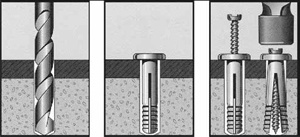Overview
The NYLON Anchor™ range of masonry anchors can be best described as light duty fasteners. They come in many different shapes
and sizes and are used extensively by the finishing trades, i.e. ELECTRICIANS, CARPENTERS, JOINERS, CEILING CONTRACTORS, PLUMBERS, AIR CONDITIONING
CONTROL ENGINEERS, SIGN WRITERS. In fact, there is not a trade in the construction industry that would not have a need at some stage to use
NYLON ANCHORS™.
They are also ideally suited to the DIY market and are sold extensively throughout the Retail Hardware Outlets.
The nylon sleeve is formed under high pressure by injection moulding, giving a tough resilient finish. Annular rings formed on the outside of
the sleeve give a positive grip against the sides of the hole once expanded. The NYLON Anchor™ comes in varying head profiles to suit the desired
application.
One must always remember that the NYLON Anchor™ is a light duty anchor, be careful not to over-specify its use for heavier duty applications.
| Features |
Benefits |
| Fast Installation |
Anchor simply hammered or screwed in |
| Versatile |
Choice of head style |
| Corrosion resistant |
Stainless steel nail |
| Economical |
Zinc plated nail |
Uses
- The NYLON Anchor™ does not pull up tight behind the material being fastened through, it merely opens the legs of the anchor causing a jamming effect
- A hand hammer is used to drive the expansion nail home, in the case of plaster sheet this could cause fracturing of the surrounding material if one is too heavy handed
- The profile of the NYLON Anchor™ head will not allow the article being installed to sit neatly against the surface, it will always stand off (stand proud) of the surface
- When fastening light sockets (batten holders) to a plaster sheet ceiling the anchor is only as strong as the surrounding surface. Batten holders are subject to twisting action and are often used to support heavy decorative light shades. The anchors will loosen off or pull out in plaster
Installation
- Drill a hole the same size as the Nylon Anchor™ body. Insert the Anchor through the material being fastened and push to its full depth in the hole.
- Insert the screw nail and tap with a hammer to expand the Anchor for secure fixing.

|